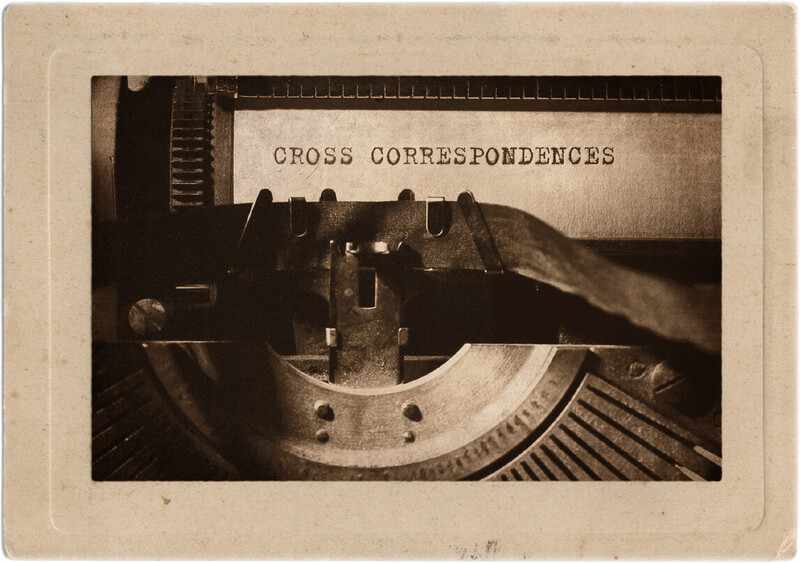Cross Correspondences

Cross Correspondences are information purportedly from discarnate personalities received by different Mediums acting independently. The information is received through trance Mediumship or Automatic Writing. There are three types of cross correspondences: simple, complex and ideal. In simple cross correspondences, two or more mediums produce the same word, words, or phrases, or similar phrases which are obviously related or interconnected. In complex cross correspondences, messages are indirect and must be deciphered.
Ideal cross correspondences involve messages which are incomplete and must be put together like pieces of a puzzle. There is no natural explanation for cross correspondences. Some psychical researchers believe they provide strong evidence in support of Survival After Death. Others say the mediums obtain the information from their own unconsciousnesses, or from each other or other living persons through unconscious Telepathy or Clairvoyance (see Super-PSI).
Cross correspondences were studied intently between 1901 and 1932 by the Society for Psychical Research (SPR), London. The most important communicators appeared to be three of the founders of the SPR, all of whom had been interested in the question of survival after death: Edmund Gurney, who died in 1888, Henry Sidgwick, who died in 1900, and Frederic W.H. Myers, who died in 1901. Of the three men, Myers was most interested in proving survival after death.
In his seminal work Human Personality and Its Survival of Bodily Death, published posthumously in 1903, Myers stated that the influence of science on modern thought might be continued after death, and that the dead would know what constitutes good evidence of survival and would discover how to produce it. He believed that producing this evidence would require a group effort on the part of the dead rather than an individual effort.
Myers stated while living that he would attempt to communicate posthumously. Sidgwick had been open to the possibility of survival, while Gurney had been skeptical. The first cross correspondences were produced by several mediums prior to Myers’s death. These were simple, showing similarities among trance utterances and automatic scripts of mediums sitting simultaneously but separate from one another.
After Myers’s death in 1901, cross correspondences became more frequent and complicated, especially in the notable cases known as the Palm Sunday Case and the Ear of Dionysius. The complex and ideal cross correspondences in these and other cases seemed to reveal an intelligent purpose behind masses of fragmentary and symbolic communications.
The messages were unintelligible to the individual mediums involved and only became coherent after much analysis and comparison. Clues to links between messages were found in classical literature, poetry, topics that had been of interest to the dead while living, and to events that had taken place in life. Literary clues also seemed to pertain to life events. Sometimes, the discovery of these obscure clues proved difficult; years were spent making sense of the communications.
By 1918, the various mediums and investigators working through the SPR concluded that cross correspondences formed large, linked groups. SPR founding member Frank Podmore was among those who believed that cross correspondences were the result of telepathic communication among the living. He suggested that one medium telepathically broadcast material, which was picked up by other mediums.
However, the fact that the individual messages seemed to have been couched in symbols, were disseminated with apparent deliberation, and were made unintelligible to individual mediums, strengthened the case for survival. The principal SPR investigators of the cross correspondences concluded that the messages were genuine communications from the discarnate personalities involved.
Leonora Piper and Gladys Osborne Leonard were among the mediums to participate in cross correspondence research. Interest waned after the 1930s, following the conclusion of the Palm Sunday Case. Cross correspondences have appeared since then in psychical research, but have not been the subject of great study.
SEE ALSO:
FURTHER READING:
- Balfour, Jean. “The Palm Sunday Case.” Proceedings of the Society for Psychical Research (SPR)52, no. 189 (Feb. 1960): 79–267.
- Douglas, Alfred. Extrasensory Powers: A Century of Psychical Research. London: Victor Gollancz Ltd., 1976.
- Gauld, Alan. Mediumship and Survival. London: William Heinemann Ltd., 1982.
- Grattan-Guinness, Ivor. Psychical Research: A Guide to Its History, Principles and Practices. Wellingborough, England: The Aquarian Press, 1982.
- Rhine, J. B., and Robert Brier, eds., Parapsychology Today. New York: The Citadel Press, 1968.
- Saltmarsh, H. F. Evidence of Personal Survival from Cross Correspondences. London: G. Bell & Sons, Ltd., 1938.
SOURCE:
The Encyclopedia of Ghosts and Spirits– Written by Rosemary Ellen Guiley – September 1, 2007










